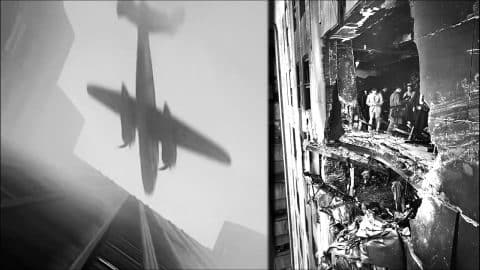
YouTube / History X
It was a foggy Saturday morning on July 28, 1945, when a B-25 Mitchell bomber crashed into the north side of the Empire State Building, resulting in an unprecedented tragedy that captured the attention of the whole nation.
Piloted by Lieutenant Colonel William F. Smith Jr., the B-25 was en route from Bedford Army Air Field in Massachusetts to Newark Airport. The tower at LaGuardia Airport reported low visibility, stating that they couldn’t see the top of the Empire State Building. Yet Smith ignored the tower’s report and flew onto Newark, became disoriented by the fog, mistook the East River to be the Hudson River, and made his turn that led him straight to the Empire State Building.
Witnesses saw the B-25 from the 38th floor on the East side of the RCA building and from the West side of the Chrysler building.
With an altitude of only 450 ft and a speed of ~200 mph, Smith attempted to go up, climbing an additional 463 ft, before impacting the Empire State Building between the 78th and 79th floors at 913 ft.

The impact and subsequent fire claimed the lives of fourteen people, including the three crew members on board the B-25. The crash caused extensive damage to the building, particularly on the 79th and 80th floors, leaving a gaping hole in its facade.
Emergency services rushed to the scene, battling the fire and assisting the injured. Despite the devastation, the Empire State Building remained structurally sound, a testament to its robust construction. Remarkably, the building reopened for business just two days later.

The investigation into the crash revealed that the combination of the heavy fog, Smith’s lack of visibility, and the limitations of the B-25’s navigational instruments contributed to the accident. This tragic incident prompted significant changes in aviation regulations, leading to improvements in instrument training and procedures to prevent similar accidents in the future.
